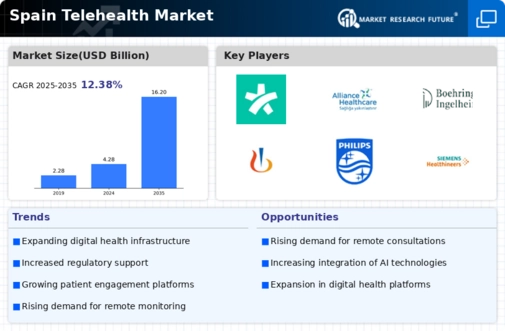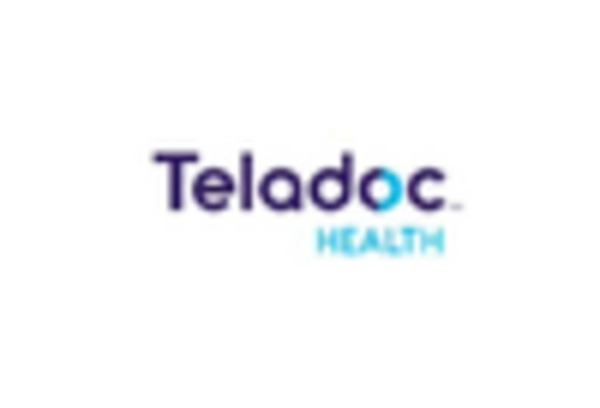Changing Patient Preferences
The evolving preferences of patients are reshaping the telehealth market in Spain. A growing number of individuals are seeking flexible healthcare options that align with their lifestyles. Surveys indicate that nearly 40% of patients prefer telehealth consultations due to their convenience and time-saving benefits. This shift in patient behavior is prompting healthcare providers to adapt their services accordingly. The telehealth market is responding by offering a diverse range of services, including mental health support and chronic disease management through virtual platforms. As patients increasingly prioritize convenience and accessibility, healthcare providers are compelled to enhance their telehealth offerings to meet these expectations, thereby driving growth in the sector.
Government Support and Regulation
Government initiatives and regulatory frameworks significantly influence the telehealth market in Spain. The Spanish government has recognized the importance of telehealth in improving healthcare access and has implemented policies to support its growth. For instance, funding programs and incentives for telehealth technology adoption have been introduced, encouraging healthcare providers to invest in these services. Recent reports suggest that public funding for telehealth initiatives has increased by 25% in the last year, reflecting a commitment to enhancing healthcare delivery. The telehealth market benefits from these supportive measures, as they create a conducive environment for innovation and expansion. Additionally, regulatory bodies are establishing guidelines to ensure the quality and safety of telehealth services, further bolstering consumer confidence in these offerings.
Increased Focus on Preventive Care
The telehealth market in Spain is witnessing a heightened emphasis on preventive care, which is reshaping healthcare delivery. As awareness of health issues rises, patients are increasingly seeking proactive measures to manage their health. This trend is reflected in the growing demand for telehealth services that focus on preventive care, such as health screenings and wellness consultations. Recent data suggests that preventive telehealth services have seen a 20% increase in utilization over the past year. The telehealth market is capitalizing on this trend by developing programs that promote health education and early intervention. By prioritizing preventive care, healthcare providers can improve patient outcomes and reduce long-term healthcare costs, ultimately benefiting both patients and the healthcare system in Spain.
Rising Demand for Accessible Healthcare
The telehealth market in Spain experiences a notable surge in demand for accessible healthcare services. This trend is driven by an increasing population that seeks convenient medical consultations without the need for physical visits. According to recent data, approximately 30% of the Spanish population expresses a preference for telehealth services, indicating a shift in consumer behavior. The telehealth market is adapting to this demand by enhancing service offerings, which include virtual consultations and remote patient monitoring. This shift not only improves patient satisfaction but also alleviates pressure on traditional healthcare facilities. As a result, healthcare providers are investing in telehealth technologies to meet the growing expectations of patients, thereby expanding their reach and improving overall healthcare delivery in Spain.
Technological Advancements in Healthcare
Technological innovations play a pivotal role in shaping the telehealth market in Spain. The integration of advanced technologies such as mobile applications, wearable devices, and high-speed internet connectivity facilitates seamless communication between healthcare providers and patients. Recent statistics indicate that over 50% of healthcare professionals in Spain utilize telehealth platforms, reflecting a significant shift towards digital solutions. The telehealth market is witnessing a transformation as these technologies enhance the quality of care and streamline operations. Furthermore, the adoption of electronic health records (EHR) and telemedicine software is becoming increasingly prevalent, allowing for better data management and patient tracking. This technological evolution not only improves efficiency but also fosters a more patient-centered approach to healthcare delivery.

















Leave a Comment